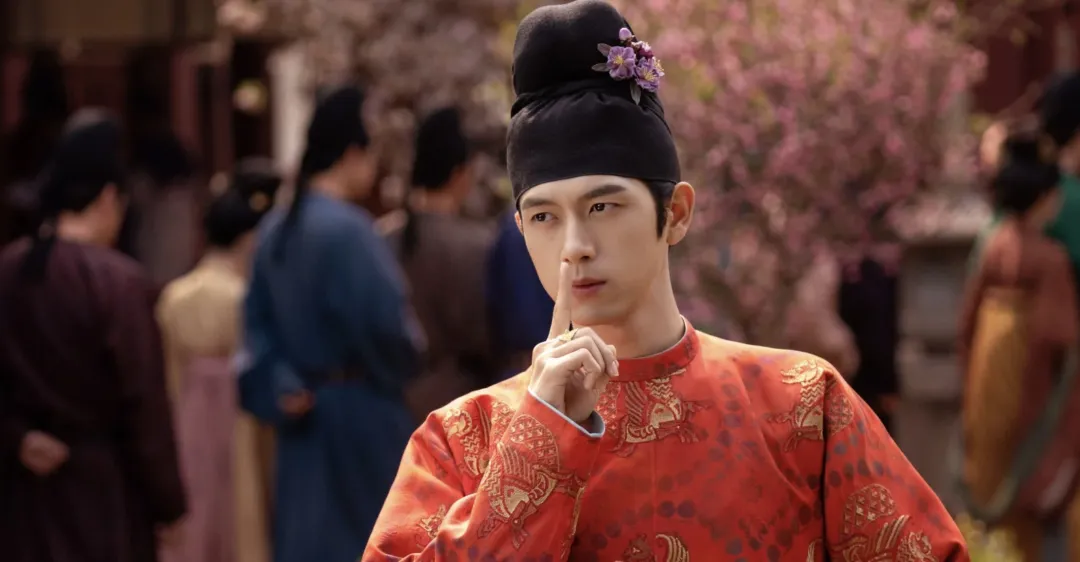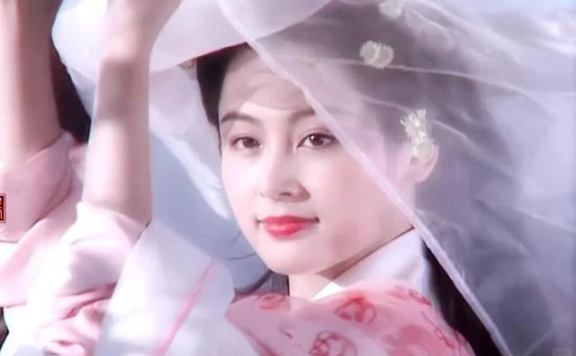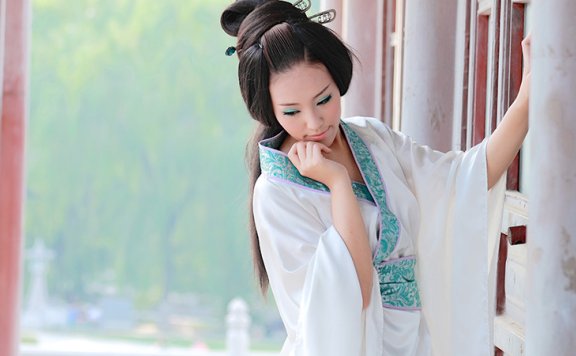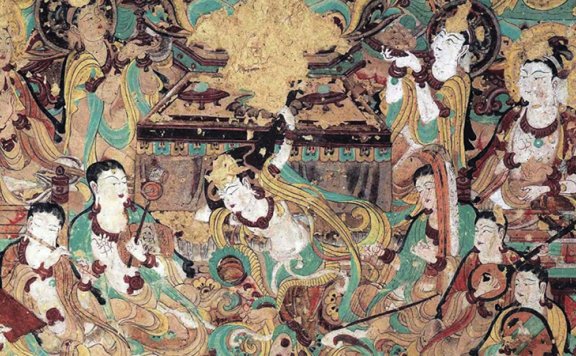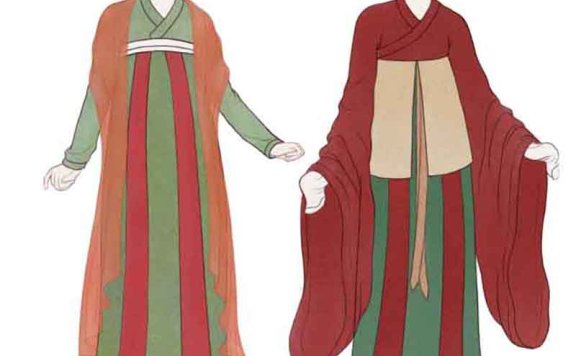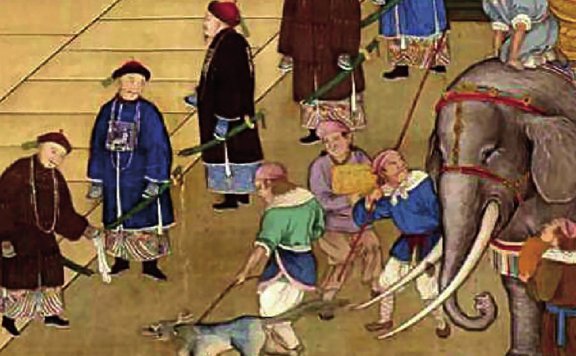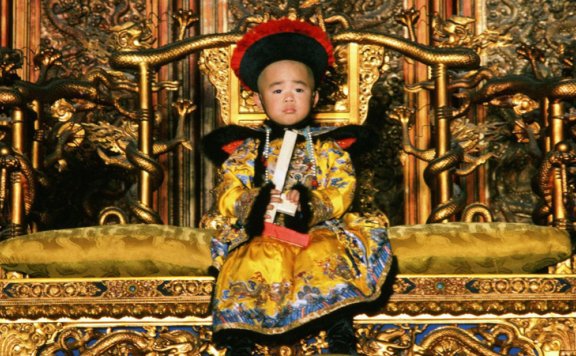Article
搜索结果:
-
Li Xian's Lavish Tang Dynasty Wardrobe in Guose Fenghua
In the drama 'Guose Fenghua', Li Xian's portrayal of Jiang Changyang features an ever-changing wardrobe, earning the title 'Tang Dynasty version of a man's closet'. Even Li Xian himself admitted that the costumes in this series are the most 'flamboyant' he has ever worn. One of the standout elements of Jiang Changyang's attire is the prominent use of Tuan Ke (团窠) and Lianzhu (联珠纹) patterns. These artistic treasures were uniquely developed during the Tang Dynasty by assimilating the essence of foreign cultures. The Persian-style Lianzhu Tuan Ke motifs, introduced to Central China via the Silk Road during the Northern Dynasties, were later infused with distinct Chinese characteristics by the Tang era. A key term to understand here is 'Lingyang Gong Yang' (陵阳公样), a category of Tang brocade patterns that dominated the textile art of the period. The 'designer' behind these patterns was Dou Shilun, a renowned Tang Dynasty silk weaving expert who created over a dozen motifs in his lifetime. According to Zhang Yanyuan's 'Records of Famous Paintings Through the Ages', Dou Shilun served as the Grand Administrator of Yizhou and was responsible for designing auspicious brocades and palace silks. His intricate and colorful designs earned him the noble title… -
The Tang Dynasty Hairstyles: Hair Buns Wrapping Face
Have you ever wondered why women in Tang Dynasty-themed films and TV shows often appear 'top-heavy'? It's not an illusion! In classical makeup and styling, the hairstyles of the mid to late Tang Dynasty are famously referred to as 'big heads.' But why? Just take a look at the number of hair buns atop their heads. The trend of 'big heads' actually began to emerge as early as the late Eastern Han Dynasty, when noblewomen started favoring high buns, considering them a mark of beauty. The Tang Dynasty took this trend to its peak, leading to the creation of various types of artificial hairpieces (Yiji) specifically for high buns. What did women do if they wanted to achieve this look but lacked enough hair? They simply wore artificial hairpieces. Common materials for Yiji included real hair or wooden substitutes. For example, this spiral-shaped Yiji was made from 'fake hair,' lined with hemp cloth, wrapped with palm fibers, and dyed to create a spiral shape. It could be easily pressed onto the head, showcasing both antiquity and craftsmanship. The materials for Yiji were diverse, not limited to real hair. Thin wooden pieces were also used. One such example is the lacquered… -
The Ancient Hairstyles of Young Maidens in Historical Dramas
In the historical drama 'Guo Se Fang Hua,' the portrayal of Yulu's maid has left a deep impression on viewers. Many netizens have humorously remarked, 'Did this hairstyle escape from a museum?' Indeed, the double - bun hairstyle, a signature look for young maidens in ancient times, holds a special place in traditional aesthetics. This hairstyle, known as Shuang Ji (双髻), was commonly worn by unmarried women, palace maids, and young servants, symbolizing youth and innocence. The Shuang Ji can be further categorized based on its shape and drooping style, such as Shuang Huan Ji (双鬟髻), Shuang Luo Ji (双螺髻), and Shuang Ya Ji (双丫髻). The foundational feature of this hairstyle is the division of hair into two equal parts, creating a symmetrical look. Each side is meticulously coiled into a small bun, typically positioned on either side of the head. The drooping version is poetically referred to as 'Shuang Chui Ji' (双垂髻). Additionally, variations like the Mao Ji (卯髻), characterized by its crescent shape, and the Huan Ji (鬟髻), featuring ring - like buns, add diversity to this traditional style. The Huan Ji often appears in pairs but can also be seen in multiples, with three or more buns… -
The Ancient Chinese Drunk Blush Makeup Trend
Have you ever wondered why some classical Chinese portraits depict women with strikingly red cheeks that almost look like bruises? This distinctive look is actually an intentional and celebrated makeup style from ancient China called Jiuyun Zhuang (酒晕妆), or "Drunk Blush Makeup." This bold cosmetic trend originated during the prosperous Tang Dynasty (618 - 907 AD), particularly popular during Empress Wu Zetian's reign. The style involved applying vibrant red pigment across large portions of the face - not just the cheeks, but often extending to the eyelids, jawline, and even ears. Historical records from the Zhuangtai Ji (妆台记), an ancient Chinese cosmetic manual, describe three intensity levels of this look: the most dramatic Jiuyun Zhuang (Drunk Blush), the softer Taohua Zhuang (Peach Blossom Makeup), and the subtle Feixia Zhuang (Flying Sunset Makeup). Beauty Standard of the Time What modern eyes might perceive as excessive was actually a sophisticated beauty standard of its time. The warm Wozhe (渥赭) hue - a traditional pigment made from cinnabar and ink - served multiple purposes: enhancing healthy complexion, creating facial dimension, and projecting an image of vitality. During mid - Tang period, women often paired this look with bold eyebrows for an even more… -
The Veiled Hat in Ancient China
In many historical dramas, the veiled hat, known as Weimao (帷帽), is an indispensable element. A classic scene often features the heroine making her first appearance, with the wind lifting the delicate veil to reveal her breathtaking beauty. This accessory has earned the playful nickname "beautiful yet useless" among netizens, highlighting its aesthetic appeal over practicality. Origin and Features The Weimao originated as a decorative item in Hu (胡) attire. Before its emergence, another style called Mili (羃篱), made of bamboo, was prevalent. Typically crafted from cloth or gauze, the Weimao features a wide brim with hanging silk nets or thin silk panels that extend to the neck, serving as a face cover. During the Sui and Tang dynasties, the hanging nets were shortened, earning it the name "Qianlu" (浅露). Unlike the Mili, which covered the entire body, the Weimao's veil only concealed the upper body. Early Usage Historical records, such as those in the "Book of Jin," note that both men and women initially wore the Mili to shield themselves from wind and sand. Over time, it became predominantly a women's accessory, used to obscure their faces from public view during outings. Some humorously suggest that introverts might have… -
Why Do Tian Xiwei and Jiang Zhenyu Wear the Same Necklace?
In recent costume dramas like "Da Feng Da Geng Ren," it's noticeable that many female characters wear the same style of necklace. Is this a trend from a specific historical period? And don't they mind wearing identical pieces? The answer lies in the term "Yingluo." Derived from the words "Ying" and "Luo," which originally referred to beautiful jade, Yingluo now signifies a multi - gemstone ornament. It's not just limited to necklaces but can also adorn armbands and shawls. In Buddhism, Yingluo symbolizes worldly treasures and is known as "infinite light," often appearing in U or V - shaped necklaces with multiple layers. Historical texts like "The Dream of the Red Chamber" and "Jin Men Yang Shi" mention Yingluo made from gold, silver, pearls, and other precious materials. During the Sui Dynasty, Yingluo was long and simple, but by the Tang Dynasty, it became shorter, more intricate, and highly popular among noblewomen. The trend influenced fashion, with materials ranging from jade to amber. Poets like Liu Yuxi and Yuan Zhen documented its popularity, and by the Ming Dynasty, Yingluo evolved into necklaces with pendants like longevity locks. Even today, Yingluo - inspired designs add a touch of classical elegance to… -
How Caoxian County Built a Hanfu Empire
In a whirl of silk and sweeping sleeves, the third Caoxian County Hanfu Cultural Festival (曹县汉服文化节) recently unveiled its 2025 spring-summer collection, dazzling audiences with runway shows that spotlighted 320 brands from 160 local companies. This spectacle wasn’t just eye candy—it cemented Caoxian’s reputation as China’s undisputed Hanfu capital. The county’s rise began in 2024 when its Horse-Face Skirts (马面裙) became a Lunar New Year sensation, propelling Caoxian to dominate 50% of China’s Hanfu market with ¥12 billion ($1.7 billion) in annual sales. By 2025, projections suggest a 15.8% quarterly growth spike. But how did this rural county transform fleeting hype into lasting influence? Government as Growth Catalyst “I finished all licensing paperwork in one day—unthinkable elsewhere!” exclaimed Mr. Li, a Hanfu manufacturer expanding his workshop. At Caoxian’s government service center, nine approval processes for Hanfu businesses were streamlined into a single “one-stop” portal, slashing processing time by 93% and paperwork by 44%. "Businesses drive this industry, but our role is to remove roadblocks," said Zhao Fulong, Caoxian’s Party Secretary. This efficiency-first ethos has fueled a manufacturing boom: today, one in two Hanfu garments nationwide originates from Caoxian factories. While viral TikTok moments grab headlines, Caoxian’s real edge lies underground—18,000… -
Why People Get So Worked Up About “Zuo Ren”
If you’ve ever wandered into the comments section of a Chinese historical drama, there’s a good chance you’ve seen someone ranting about whether the actors are wearing their robes “correctly.” And by “correctly,” they often mean one of two things: first, is the hair tied up or left loose? And second, is the robe crossing left-over-right (zuo ren, 左衽) or right-over-left (you ren, 右衽)? This second one—zuo ren—is where things get weirdly intense. What Does “Zuo Ren” Actually Mean? So what’s the big deal with zuo ren? Technically, it refers to the way a garment crosses over the body. If the left side overlaps the right, that’s zuo ren. Right over left? That’s "you ren", which is traditionally considered “correct” in Han Chinese dress. Confucius (孔子) even name-dropped zuo ren in the Analects (论语) , saying that if not for the statesman Guan Zhong (管仲) , “we’d all be wearing our hair down and robes crossed the wrong way”—basically, we’d be living like barbarians. Which sounds dramatic. But here’s the thing: even in Confucius’s time, not everyone outside the Central Plains actually wore zuo ren. For example, the people of Chu (楚国) —a powerful southern state considered “semi-barbaric” at the… -
When Gods Painted the Walls: Seeing Dunhuang Through Modern Lens
It’s funny how we throw around the word “Dunhuang” like it’s a single, well-defined thing. For most people, it’s synonymous with the Mogao Caves—those dusty, majestic Buddhist grottos in the far-flung desert of northwestern China. But Dunhuang (敦煌) is less of a place and more of a time capsule layered with over a thousand years of belief, brushstrokes, and guesswork. It isn’t just one cave, one dynasty, or one style. It's an ecosystem of art, faith, and faded colors—held together by sand and memory. Let’s clear one thing up first: Dunhuang isn’t just the Mogao Caves. It includes the Yulin Caves (榆林窟), the Western Thousand Buddha Caves (西千佛洞), and even more obscure clusters like the Five Temple Caves (五个庙石窟). It's more accurate to call it the Dunhuang Grotto Complex—a network of spiritual and artistic experimentation that unfolded across centuries. Not Just Tang Dynasty Grandeur We love to associate Dunhuang with the Tang Dynasty (唐朝)—maybe because the Tang's cultural glamor fits so neatly with the image of heavenly bodhisattvas strumming pipa mid-air. But that's a postcard version of Dunhuang. In truth, the site saw activity from the 4th to the 14th century, spanning dynasties like the Northern Wei (北魏), Sui (隋),… -
The Fascinating World of Ancient Chinese Collars
When we think of ancient Chinese clothing, one of the first things that come to mind might be the iconic "y"-shaped collars seen in many historical dramas. These images, often simplified for visual appeal, don’t quite capture the complexity and diversity of collar styles throughout China’s long history. From the loose, expansive collars of the Northern Dynasties to the structured, high collars of the Ming and Qing periods, the evolution of the collar is a testament to both fashion and function. A Closer Look at the "Big Collar" Trend The concept of the "big collar" in Chinese historical attire is intriguing because it defies many modern expectations about what a collar should look like. Rather than being a rigid feature of the garment, the collar often served as a playful and dynamic part of the outfit’s overall structure. Take, for instance, the mural from the tomb of Xu Xianxiu (徐显秀) of the Northern Qi (北齐) Dynasty. The image depicts his wife wearing an outfit with an unusually large collar that seems far from the typical “cross-collar” or “y”-shaped design that we expect from Chinese traditional garments. At first glance, the garment worn by Xu Xianxiu’s wife might look like a… -
The Hanfu Boom: A Guide to Leading Brands
Hanfu (汉服, traditional Chinese clothing) isn’t just a nostalgic trend—it’s a global movement. What began as a niche subculture in China has evolved into a thriving industry, with brands blending historical accuracy with modern wearability. Forget stiff costumes; today’s Hanfu ranges from silk-adorned ceremonial robes to minimalist office-friendly pieces. Here’s a breakdown of the brands driving this revival, their signature styles, and why they resonate with Gen Z shoppers from Los Angeles to Jakarta. 1. Minghuatang (明华堂) Founded in 2007, this Guangzhou-based label has become synonymous with meticulous craftsmanship and eye-watering price tags—think ¥10,000 ($1,400) for a single set, with wait times stretching up to a year. https://www.youtube.com/watch?v=guu1ad17AH8 The Founder’s Obsession Hong Kong-born Zhong Yi (钟毅), a fashion design graduate from Guangzhou Academy of Fine Arts, noticed something odd in the early 2000s: At formal events, Koreans wore hanbok, Japanese wore kimono, but Chinese attendees rarely wore Hanfu. He started designing his own pieces, wearing them daily to normalize the tradition. In 2007, he co-founded Minghuatang with a clear mission: to recreate historically accurate Ming Dynasty (1368–1644) attire with museum-level precision. What Justifies the Price? Minghuatang’s garments aren’t just costumes—they’re wearable history. Every stitch follows 15th-century texts and artifacts, from… -
Draped in Dynasty: Tang Female Attire
In Tang Dynasty China, women’s fashion followed a consistent formula: a layered ensemble of shan (衫, a short top), ru (襦, a lined jacket), ku (袴, trousers or leggings), and qun (裙, skirts), often draped with a long, flowing pei (帔, a silk stole). But like modern trends, styles evolved—shifting from slim, fitted cuts in the early Tang to voluminous, relaxed silhouettes by the late Tang. This piece traces the evolution of women’s fashion across the Sui, Tang, and Five Dynasties. Each section opens with a vignette inspired by legendary figures—like the runaway courtesan Hongfu (红拂), the politically savvy Shangguan Wan’er (上官婉儿), or the tragic beauty Yang Yuhuan (杨玉环)—paired with reconstructions of their likely outfits. Drawing from archaeological finds, paintings, and sculptures, we’ve pieced together how these women might have dressed. But first, a primer on Tang textiles. The Fabric of Tang Fashion Silk fabrics were woven from intersecting threads: jing (经, warp, the lengthwise threads) and wei (纬, weft, the crosswise threads). Variations in these threads created intricate patterns. 1. Plain Weaves: Juan & Shi Juan (绢): A basic plain-weave silk, utilitarian and widely used. Shi (絁): Similar to juan, but with uneven weft threads, creating subtle horizontal stripes.… -
Ancient Chinese Fashion: A Misunderstanding of Seasonal Wear
When we think about ancient Chinese clothing, a curious misunderstanding often arises—many believe that the clothing of specific dynasties was determined by the seasons. For instance, people sometimes think of Tang Dynasty garments as summer wear, and Ming Dynasty attire as winter clothing. The idea seems odd at first, as we know that every era experienced all four seasons, so why would the clothing of one dynasty be associated with just one temperature? It turns out that this perception stems from a combination of misinterpretations and misconceptions about the nature of ancient Chinese garments. Let’s break down why this understanding doesn’t quite hold water. The Tang Dynasty: More Than Just Summer Fashion The Tang Dynasty is often associated with light, airy, and flowing garments, especially the famous "Qixiong Ruqun", which has become iconic in many representations of ancient Chinese fashion. This lightweight attire—made from silk and other fine materials—gives the impression of being suited for hot weather. But the truth is, Tang fashion wasn’t just about comfort during the heat. A deeper look reveals that many Tang garments, although appearing simple, actually consisted of several layers, which weren’t always visible on the surface. The illusion of "light" clothing in modern… -
Traditional Chinese Hairstyles for Children
Historical Cdramas like 'Qing Ping Yue' and 'Da Feng Da Geng Ren' have showcased authentic children's hairstyles, moving away from the trend of simply shrinking adult styles. This shift highlights that ancient Chinese children, much like their modern counterparts, had their own distinctive looks tailored to their age. Previously, it was common to see ten-year-olds in period dramas styled as miniature adults—boys with tied-up hair and crowns, girls with elaborate buns and hairpins. However, this portrayal is historically inaccurate. In ancient China, adulthood was marked by ceremonies: the Ji Ji Li (及笄礼) for girls around age 15 and the Ruo Guan Li (弱冠礼) for boys around 20. Before these rites, hairstyle options were limited, with the most common being the 'Zong Jiao' (总角), or 'horned hair'. Zong Jiao: A Broad Term Zong Jiao is a broad term referring to the hairstyles of children aged 7 to 15. This period was poetically called the 'Zong Jiao Years,' and childhood friendships were termed 'Zong Jiao friendships.' The 'Jiao' refers to small topknots, specifically the hair tied on either side of a child's head, distinct from the loose 'Chui Tiao' (垂髫) of early childhood or the formal buns of adults. Narrow Definition of… -
Pearl Adornments in Song Dynasty Fashion
During the Song Dynasty, pearl embellishments were a widespread fashion trend, but contrary to popular belief, the number and placement of pearls did not signify social status or rank. While official attire for noblewomen and imperial consorts had strict regulations regarding patterns and motifs—such as the number of dragons or phoenixes on headdresses—pearl adornments were never subject to such hierarchical rules. Online claims suggesting that the quantity of pearls indicated one's rank are simply unfounded interpretations. Pearls were a universal fashion statement. Even the empress wouldn’t cover her entire face in pearls, as there were only a few suitable spots for application: between the eyebrows, from the corners of the eyes to the temples, and on the dimples. Though the number of pearls didn’t reflect social rank, using more pearls naturally hinted at a wealthier background. Affluent families didn’t just wear pearls on their faces or as jewelry; they also embellished collars, cuffs, carpets, and even furniture with pearls, turning them into a ubiquitous decorative element. One popular style was the 'Zhuluo' (珠络), where pearls were sewn along collars, hems, and seams to accentuate the wearer’s status. Princesses’ dowries included pearl-adorned formal gowns and long coats, as well as 'Pearl… -
Why Do These Ancient Drama Wedding Crowns Look So Familiar
In the ancient costume drama 'The National Beauty and Fragrance,' these two grand wedding crowns have sparked much discussion, primarily due to their extravagance and intricate details. From a cultural relic perspective, they seem to reference certain prototypes, appearing quite authentic at first glance. However, upon closer inspection, something feels off. Why is that? Previously, we discussed the 'sky-high' crown of Princess Xianzhu, Li Chui. For those interested, you can refer to another article. Today, we’ll focus on the crown worn by Yang Zi’s character, He Weifang, during her wedding. It’s worth noting that the crowns in these dramas are becoming increasingly lavish. Interestingly, what’s referred to as a 'crown' here is more akin to a set of accessories in Tang Dynasty style. Let’s delve deeper. To start with a conclusion, this crown’s original prototype likely stems from the crown of Empress Xiao of the Sui Dynasty. Although it underwent some stylistic changes during the Sui and Tang Dynasties, it retained elements like hairpins (Chaidian) and side ornaments (Bobin) as markers of status. Regardless of these changes, the number of Bobin and floral decorations (Huashu or Huadian) was still determined by the rank of noblewomen or female officials. According to… -
The Trend of Baby Hair Bangs in Historical Dramas
Recently, baby hair bangs have made a reappearance in historical dramas. While these bangs can help contour the face, they often seem out of place in classical settings. Historically, adult women in ancient China did not wear bangs, as they were considered a transitional hairstyle for children whose hair had not fully grown. Upon reaching adulthood, women would style their hair neatly using traditional hair products like "paohua shui" (刨花水), emphasizing elegance and sophistication. Although baby hair or air bangs may appear more natural compared to other fringe styles, they still disrupt the authenticity of classical aesthetics. This article focuses solely on the appropriateness of bangs in historical contexts, not on personal appearances. Retaining baby hair bangs can make a character look immature. For instance, actress Ju Jingyi (鞠婧祎) was often criticized for her unchanging baby hair bangs, but her recent updos have showcased a more mature and classical demeanor. In the drama "The Purple Hairpin," the inclusion of such bangs felt particularly jarring amidst otherwise historically accurate hairstyles. Conversely, in "The Riverside Scene at Qingming Festival," Zhang Xinyu's (张馨予) noblewoman look without bangs exuded grandeur. The no - bangs style cleverly utilized "yunbin" (云鬓), a classical hairstyle from the… -
Maximizing Your Disney Vacation Club Membership: Tips and Tricks
Dreaming of magical mornings at the Magic Kingdom and unforgettable nights at Epcot? A Disney Vacation Club (DVC) membership can make that dream more than a wish-it can make it your new reality. DVC provides savings, flexibility, and unique perks. Whether you've loved Disney for years or are just beginning, you'll have access to benefits that regular guests won't find. The key lies in knowing how to make the most of it. From smarter point-of-planning to unlocking hidden benefits, there's a world of opportunity waiting. Ready to discover how to stretch every point and maximize every moment? Keep reading-you're about to unlock the magic. Understanding Your Points and When to Use Them A Disney Vacation Club membership's key aspect is using points effectively, as you receive a set number each year. You can bank or borrow points for flexibility and consider planning trips during peak seasons to maximize their value. Opting for less popular booking times, like late summer or early fall, can help you save points and enjoy lower crowd levels. Take Advantage of Member Discounts DVC members enjoy valuable perks beyond accommodations, including discounts on dining, merchandise, and events, making trips more cost-effective. The DVC website often updates offers,… -
Tang Dynasty Series Guide: Empresses, Poets, and Palace Treason
In 618 CE, as Sui Dynasty excesses sparked rebellion, a daring aristocrat named Li Yuan seized Chang'an, founding the Tang Dynasty (618–907 CE). Under his son, Emperor Taizong, Tang became a golden age—a cosmopolitan empire where Persian merchants, Korean scholars, and Uyghur horsemen mingled in silk-clad streets. Poetry flourished with Li Bai's verses, diplomacy stretched to Baghdad, and Buddhist pagodas pierced the skies. Yet Tang's splendor was tempered by treachery: palace coups, concubines' schemes, and the cataclysmic An Lushan Rebellion that left a million dead. The Tang's two centuries of zenith saw unmatched innovation: woodblock printing spread knowledge, imperial exams elevated commoners, and women like Empress Wu Zetian shattered ceilings, ruling as China's sole female emperor. But this was also an era of extremes. Emperor Xuanzong's passion for concubine Yang Guifei birthed both art and ruin, while the Silk Road brought riches—and bloodshed—as Tibetan and Turkic armies challenged Tang's borders. Hungry for opulence and intrigue? Step into the splendor of Chang'an's lantern-lit nights, where poets duel with brushstrokes and spies whisper in tea houses. Marvel at Wu Zetian's ruthless ascent from concubine to empress, or let your heart break with the tragic romance of Xuanzong and Yang Guifei—a love that… -
From Forbidden City to Screen: Qing Dynasty Sagas Reimagined
In 1644, as the Ming Dynasty's fading glory shattered beneath peasant uprisings and Manchu cavalry, a steppe chieftain's descendant named Nurhaci's dream materialized. His descendants crossed the Great Wall, founding the Qing Dynasty (1644–1912), a realm where Manchurian martial vigor entwined with Confucian statecraft to forge China's final imperial colossus. Spanning nearly three centuries, this era fused conquest and cosmopolitanism, its legacy echoing through jade-adorned palaces and blood-soaked battlefields alike. The Qing is framed by its zenith under Kangxi and Qianlong, and its unraveling in the 19th century's opium-hazed twilight. From the Treaty of Nerchinsk to the Boxer Rebellion's flames, the dynasty oscillated between global engagement and xenophobic isolation. Beneath the Forbidden City's gilded roofs, empresses plotted behind silk curtains, Han literati navigated Manchu rule, and eunuchs wielded shadows as currency. Yet beyond the palace walls, a multicultural tapestry thrived—Jesuit astronomers mapped stars, Mongol khans swore fealty, and Cantonese merchants traded tea for silver. Let us enter a world where dragon robes conceal daggers, and every courtyard murmurs with ambition. Follow the Kangxi Emperor, a boy-king who tamed regents and rebels to become Asia's longest-reigning monarch. Ride with the feared Eight Banners across Tibetan plateaus, and walk the Guangzhou docks…
